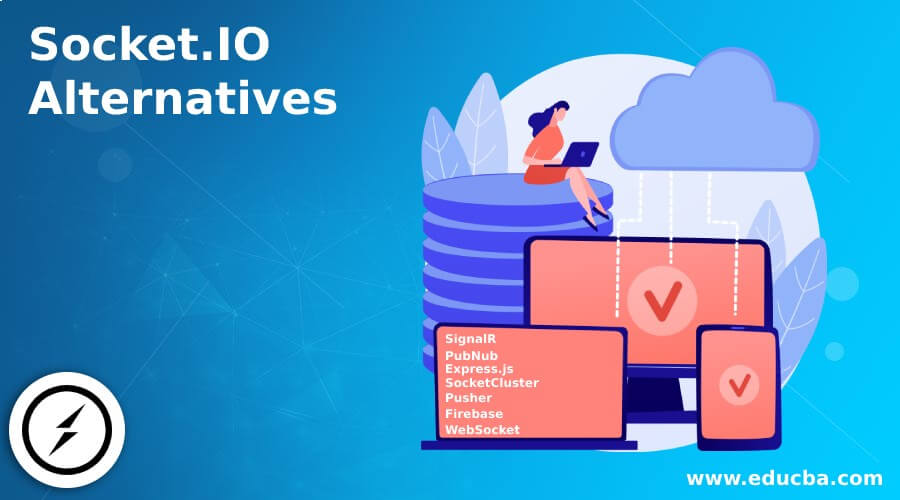Updated June 13, 2023

Introduction to Socket.IO Alternatives
The following article provides an outline for Socket.IO Alternatives. Socket.IO allows two-way event communication in real time. It works on all platforms, browsers, or devices with an equal focus on reliability and speed. Socket.IO is based on the WebSockets API and Node.js. Therefore, Socket.IO Alternatives is one of the most library-dependent (Node Package Manager). The WebSocket protocol with polling as an option for fallback, and the same interface is used in Socket.IO. Although Socket.IO Alternatives can only be used as a web socket wrapper, it offers numerous other features, such as multiple sockets, customer-related storage of data, and asynchronous I/O.
List of Socket.IO Alternatives
Given below is the list of Socket.IO Alternatives:
1. SignalR
SignalR does automatic control for connection management for ASP.NET Core. If you think of an example chat room, SignalR can simultaneously send messages to all connected customers. It can also send messages to a particular client or customer group. Later, you will see how we look at the interface properties and methods of IHubCallerClients.
2. PubNub
PubNub is a San Francisco-based, California, real-time communication and service infrastructure (IaaS) company. The company produces products to create a real-time mobile web for software and hardware developers. The primary product of PubNub is a publication/subscription Message API built on its worldwide network for data streaming consisting of a replicated network of at least 15 data centers in North America, South America, Europe, and Asia. The network now serves over 330 million devices and transmits over a trillion messages monthly.
3. Express.js
Express.js is a web application framework free and open-source for Node.js. It is used fast and easily to design and construct web applications. You can run web apps on a web browser or web applications. Because Express.js requires only JavaScript, building Web Applications and APIs by programmers and developers is easier. Express.js, being a Node.js framework, implies that most programmers’ code is already written for its usage. You can use Express.js to create multipage, one-page, or hybrid web applications. Express.js is lightweight and helps you to create a more organized MVC architecture for web applications on the server side.
4. SocketCluster
The problem with cloud-based services such as PubNub, Pusher, and Firebase is that the backend is subject to custom logic and pricing. The .io socket appears to have a wider development community, which is quite good for the environment and flexible architecture of the API. SocketCluster is a real-time Node.js open-source framework. It supports direct communication between client servers and the group via advertising / sub-chain. It is designed to scale easily to various processes/hosts and is ideal for constructing chat systems.
5. Pusher
Pusher sits between servers and clients in a real-time layer. The pusher maintains persistent customer connections via WebSocket and returns to HTTP connectivity if possible. So that, instantly via Pusher, your servers have new data they want to pass on to clients. In all main runtimes and frames, Pusher provides libraries that integrate. Java, Go and Node, JavaScript, great range of clients, including GitHub, CodeShip, MailChimp, The Financial Times, Travis CI, UserVoice, and QuizUp. This solution is highly scalable in real time.
6. Firebase
The backend as a Service is Firebase (Baas). It offers a range of tools and services to help develop quality apps, build their user base and profit. It is based on the infrastructure of Google. Firebase does not categorize a NoSQL database program that stores JSON-like documents. Nowadays, there seems to be an app for everything. Well, nearly all. We did not find an app to help me remove the impacted earwax. Sometimes it happens, and it’s very disgusting.
7. WebSocket
WebSocket is a computer communication protocol that supplies a single TCP connection with a full-duplex communication channel. In 2010, the IETF standardized the WebSocket protocol to RFC 6455, while the W3C standardizes the WebSocket API in Web IDL. HTTP differs from WebSocket. Both protocols in the OSI model are in layer 7, depending on the TCP of layer 4. While different from each other’s, RFC 6455 states that WebSocket’s “compatibility with the HTTP protocol is designed to work with 443 and 80 HTTP ports and to support proxies and intermediaries.” For the WebSocket handshake to achieve compatibility, the HTTP Upgrade header is used to change the HTTP to the WebSocket protocol.
Conclusion – Socket.IO Alternatives
In this article, we have seen various socket.io alternatives. You can choose any of them based on your requirements.
Recommended Articles
This is a guide to Socket.IO Alternatives. Here we discuss the introduction and the list of Socket.IO alternatives for better understanding. You may also have a look at the following articles to learn more –
